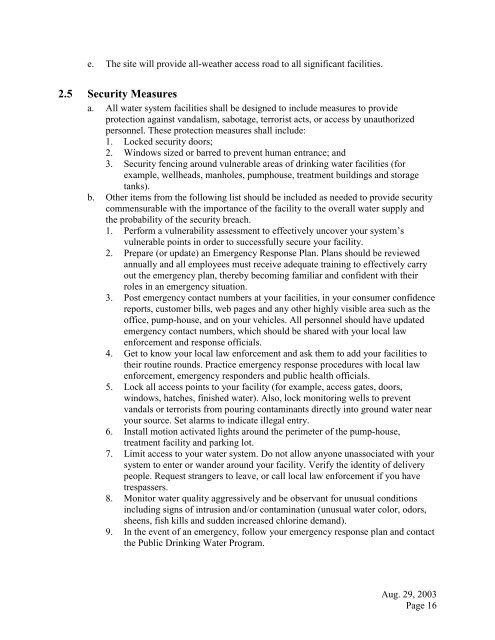Design Guide for Community Water Systems - The Water, Sanitation ...
Design Guide for Community Water Systems - The Water, Sanitation ...
Design Guide for Community Water Systems - The Water, Sanitation ...
You also want an ePaper? Increase the reach of your titles
YUMPU automatically turns print PDFs into web optimized ePapers that Google loves.
e. <strong>The</strong> site will provide all-weather access road to all significant facilities.2.5 Security Measuresa. All water system facilities shall be designed to include measures to provideprotection against vandalism, sabotage, terrorist acts, or access by unauthorizedpersonnel. <strong>The</strong>se protection measures shall include:1. Locked security doors;2. Windows sized or barred to prevent human entrance; and3. Security fencing around vulnerable areas of drinking water facilities (<strong>for</strong>example, wellheads, manholes, pumphouse, treatment buildings and storagetanks).b. Other items from the following list should be included as needed to provide securitycommensurable with the importance of the facility to the overall water supply andthe probability of the security breach.1. Per<strong>for</strong>m a vulnerability assessment to effectively uncover your system’svulnerable points in order to successfully secure your facility.2. Prepare (or update) an Emergency Response Plan. Plans should be reviewedannually and all employees must receive adequate training to effectively carryout the emergency plan, thereby becoming familiar and confident with theirroles in an emergency situation.3. Post emergency contact numbers at your facilities, in your consumer confidencereports, customer bills, web pages and any other highly visible area such as theoffice, pump-house, and on your vehicles. All personnel should have updatedemergency contact numbers, which should be shared with your local lawen<strong>for</strong>cement and response officials.4. Get to know your local law en<strong>for</strong>cement and ask them to add your facilities totheir routine rounds. Practice emergency response procedures with local lawen<strong>for</strong>cement, emergency responders and public health officials.5. Lock all access points to your facility (<strong>for</strong> example, access gates, doors,windows, hatches, finished water). Also, lock monitoring wells to preventvandals or terrorists from pouring contaminants directly into ground water nearyour source. Set alarms to indicate illegal entry.6. Install motion activated lights around the perimeter of the pump-house,treatment facility and parking lot.7. Limit access to your water system. Do not allow anyone unassociated with yoursystem to enter or wander around your facility. Verify the identity of deliverypeople. Request strangers to leave, or call local law en<strong>for</strong>cement if you havetrespassers.8. Monitor water quality aggressively and be observant <strong>for</strong> unusual conditionsincluding signs of intrusion and/or contamination (unusual water color, odors,sheens, fish kills and sudden increased chlorine demand).9. In the event of an emergency, follow your emergency response plan and contactthe Public Drinking <strong>Water</strong> Program.Aug. 29, 2003Page 16
















